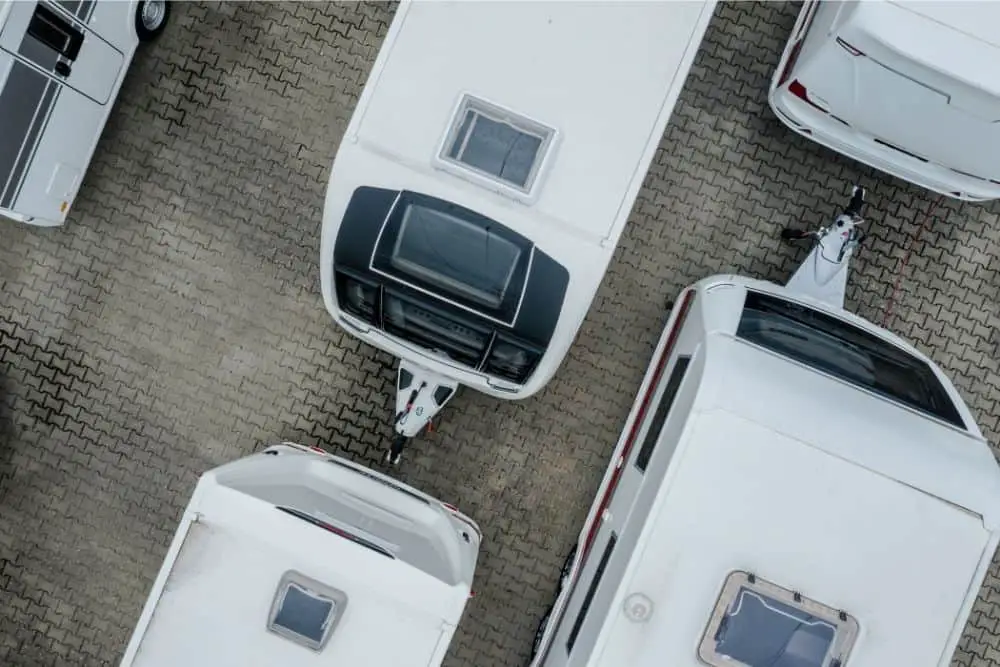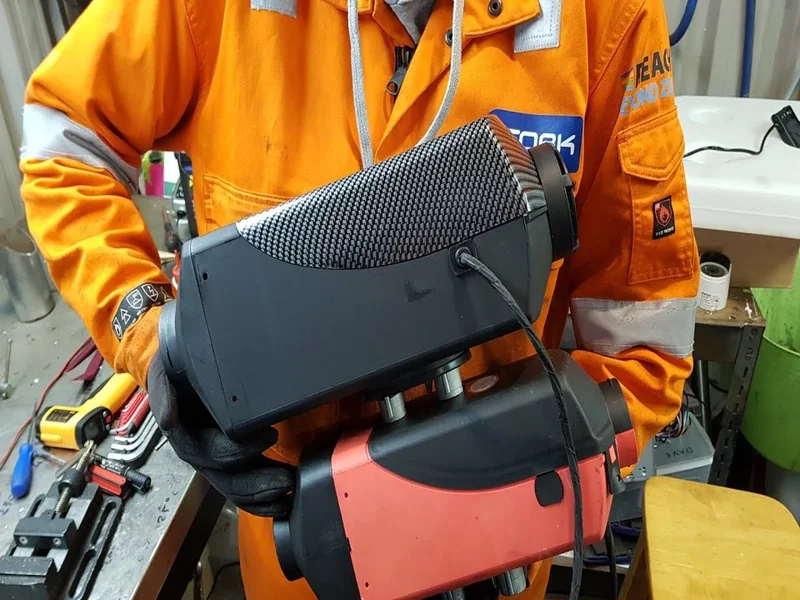Unless you accidentally punched a hole in your RV wall, finding a hole there is a matter of concern. Mostly, that’s because you need to determine what caused it. Was it an impact force? Is it the result of rot that’s permeated through the wall? Is it structural? Is it water damage? What kind of material is it?
Repairing a hole in your RV wall could take ten minutes (for a quick patch) or hours of reconstructive work. Either way, it can be done with the right materials and tools but most importantly, you can fix it as a DIY project, without forking over a fortune to a professional.
The only exception to that rule would be massive rot within the walls, possibly including mold or fungus. Of course, that’s something that you would probably only see if your RV was seriously neglected or if you inherited/purchased a used one that was neglected.
What Are RV Walls Made of?
With a typical RV wall, you have three layers: The external shell, the center (mostly comprised of insulation), and the interior wall. Unlike house walls, RV walls are compressed together far more tightly, which saves room.
Unlike repairing walls within your home, you won’t have to worry about whether or not the wall is load-bearing—they’re not—and the repair process is generally well within most budgets and fairly simple to do.
The exterior wall makes up the largest part of load-bearing material and is typically rigid, whether it’s a Winnebago or an Airstream. Throughout the industry, there are usually three different types of inner materials.
- Vinyl
- Fiberboard
- Plywood
Each one of these is easily replaceable and relatively cheap, even if you need a good amount of any one of them.
Determining What Caused the Damage
As aforementioned, if you discover a hole in your RV wall, and you know that it wasn’t caused by impact force, it’s important to find out what caused the hole to begin with. If there is significant water damage behind the wall, it would be very easy for the lightest force to poke a hole in it.
If it is indeed water damage, the source of the water needs to be located and stopped. There’s no sense in proceeding with any level of repair if there is still a danger of water getting behind the wall again.
Most water damage in an RV starts in the roof or up from the floor, so those are the two areas you will need to inspect thoroughly if there is water damage in the walls. In some cases, it is worth checking canvas, especially on pop-top roof caravans, which are quite easy to fix.
If you are just dealing with a hole in the wall, or if you’ve figured out the water leak and rectified the situation, everything becomes much easier from here.
Ten Minute Patch
For a quick patch on a small hole, determine the material you are dealing with. You can use drywall mesh for large holes or fill in holes in fiberboard. For wood and vinyl, a spackle or foam insulation will do just fine.
To start, clean the edges of the hole and remove any looks debris or fibers. If necessary work some sandpaper into the hole and smooth out the edges all the way around. You want your filler material to adhere to strong edges rather than loose wood or fiberboard.
Clean away any excess don’t from sanding and insert your filler material. Put more in than the hole can contain so that it bulges out from the hole a little. Use a scraper to flatten it out.
Later, once it’s dry, come back and briefly and lightly sand the surface so that it’s all flush. Wipe away the don’t and paint the section whatever color your heart desires.
Choosing Your Replacement Material for Larger Holes or Damage
You might assume that you would just go out and select the same, exact material that was damaged and replace it with that. However, when it comes to interior wall paneling in RVs, the options are nearly endless.
There’s also the possibility that you are remodeling and fixing the hole as a catalyst or that you just want to go with an entirely different design altogether as you patch the hole.
There are also a lot of great ideas for using other materials to patch a hole and take advantage of that material as it is installed on top of the original. Whatever you choose to do, you still have to choose a material and go with it.
The first thing that you should do—especially if the hole is rather small—is purchase a section of ⅛” plywood to insert into the wall before you cover it with the final paneling. If any of the insulation can be salvaged, do so as well, but the plywood will be more than enough for small repairs.
Most RV panels will run for around $30 for a 4’ x 8’ section and the price differences between materials are largely negligible. Just remember to take your time with it and pick something out that works for you. It’s going to last for a while, after all.
Removing the Old Panels
This isn’t a difficult task and can usually be done in around ten or fifteen minutes. The tools that you will need are:
- Hammer
- Heavy-duty scraper
- Measuring tape
Don’t forget to pick up the section of ⅛” plywood either. You won’t need it if the replacement panel is thick enough, however, it’s often difficult to find replacement panel material that comes out exactly as it should be in terms of thickness.
As far as removing the old panel is concerned, almost all RVs are designed with the interior walls entirely comprised of panels and it’s only a matter of removing them by systematically going through with a hammer and prying out the nails/staples along the border until the panel is free.
Often, a sturdy scraper will come in handy to wedge between panels to aid in prying the desired panel out. Once it’s clear, go about the business of making sure all of the staples or nails are completely removed.
Once that’s done, remove any wall studs that have sustained damage, along with any residual insulation. Grab your tape measure and get a precise measurement of every corner, cranny, elbow, and odd space so that you can get a perfect fit with the new, replacement panel.
Installing the New Panel
Here’s where your choice of material is going to matter. If you stick with wood paneling, you would do well to use a nail gun with the appropriate size staples or nails. If you go with vinyl or fiberboard, lies and adhesives are the order of business.
Choosing an adhesive will be a breeze, simply because there are so many on the market, you’ll have endless options for what you want to go with. Once you have adhesive in hand, the rest is pretty easy.
Take your adhesive and draw a bead along the edges of the backside of your new panel—in a straight line where it will butt up against the studs—and then draw a separate bead along the stud where the panel will be installed.
There’s no need to go overboard with the adhesive. You’re going to place a thin bead down on both, opposing sides and bring them together, which will be more than enough to secure your new panel and when it dries, it will be more difficult to remove than a nailed-in panel.
What Are Some Good Adhesives?
When we mentioned the fact that there are endless supplies of adhesive brands and types on the market, we didn’t mean to get the cheapest possible one. It’s great to have some variety but a cheap fix is more like placing a band-aid on a featuring wound.
For non-vinyl applications, two high-quality adhesives are OSI Heavy Duty Shear and Construction and Titebond 5352. Both adhesives are great products and highly reviewed, however, if you have vinyl panels, you’ll have to look elsewhere as these won’t work.
For more versatility in your adhesives, Loctite Power Grab is an excellent choice, as it adheres to most materials and will even do so in wet conditions (though that shouldn’t be your first choice).
J.B. Weld is another popular choice due to its bonding strength and its versatility. There are two kinds to choose from if you want to secure RV panels to wooden or metal studs: the standard, J.B. Weld compound, and J.B. Weld Kwik Weld.
With either compound, you could vice grip a key together that has been snapped in half and it would hold together stronger than the original metal. This is really quality stuff but be careful not to get any on you, as both are fast-acting and potent.
Final Word
Whether it’s a lot of damage or just a small puncture in your RV walls, the solution is pretty straightforward and quick. Better yet, these are DIY projects through and through. You won’t need a professional to fix an RV panel unless you are dealing with significant water damage or something similar.








